How to encourage networking during your events

People go to events for a lot of reasons.
They go to learn more about industry trends and innovations.
They go to escape the routine and freshen up their perspectives.
They go to be entertained or have a unique experience.
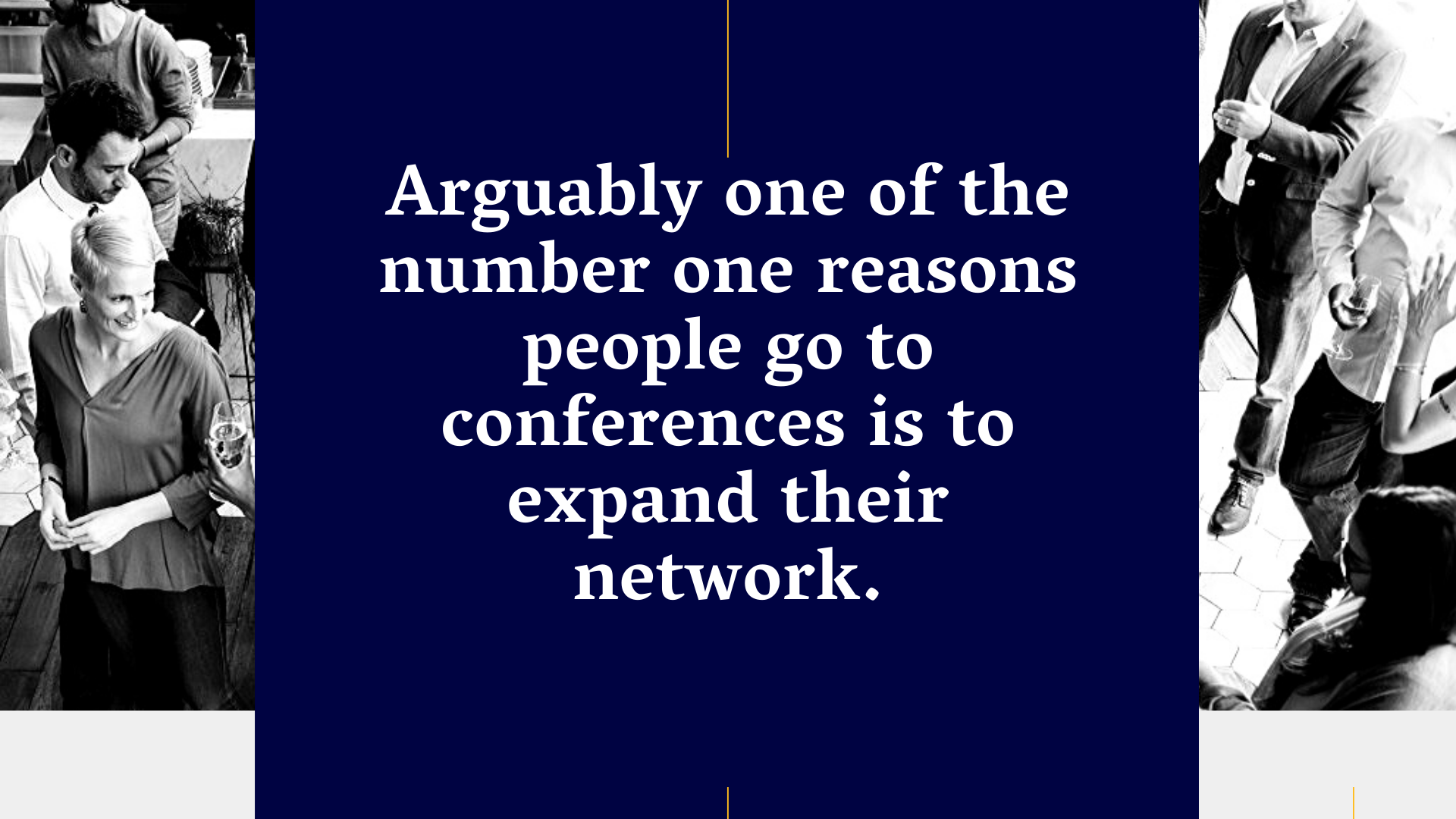
But arguably one of the number one reason people go to conferences is to expand their network.
People want to connect. And events are the perfect place to make the right connections.
According to the Event Manager Blog, 82% of corporate event attendees named networking their priority. This makes networking the top reason why people attend events:

Image statistics via Event Manager Blog
According to the same source, planners benefit from networking no less than event attendees.
Reportedly networking is the most effective strategy for the event planners to find new clients, with 66% of respondents supporting this claim.
So what is the formula for successful networking?
How to encourage networking during your events?
Let’s take a look.
1. Create a fertile ground for networking
What you do be for the event (pre-event) is crucial for setting up effective networking.
Steps on the pre-event stage:
A. Go big on social media
Social platforms are the most effective tool to encourage networking before the event.
Attendees can leave comments, questions, and feedback.
Clever attendees looking to see who else will be attending check out the list of people who are interested in/going to the event.
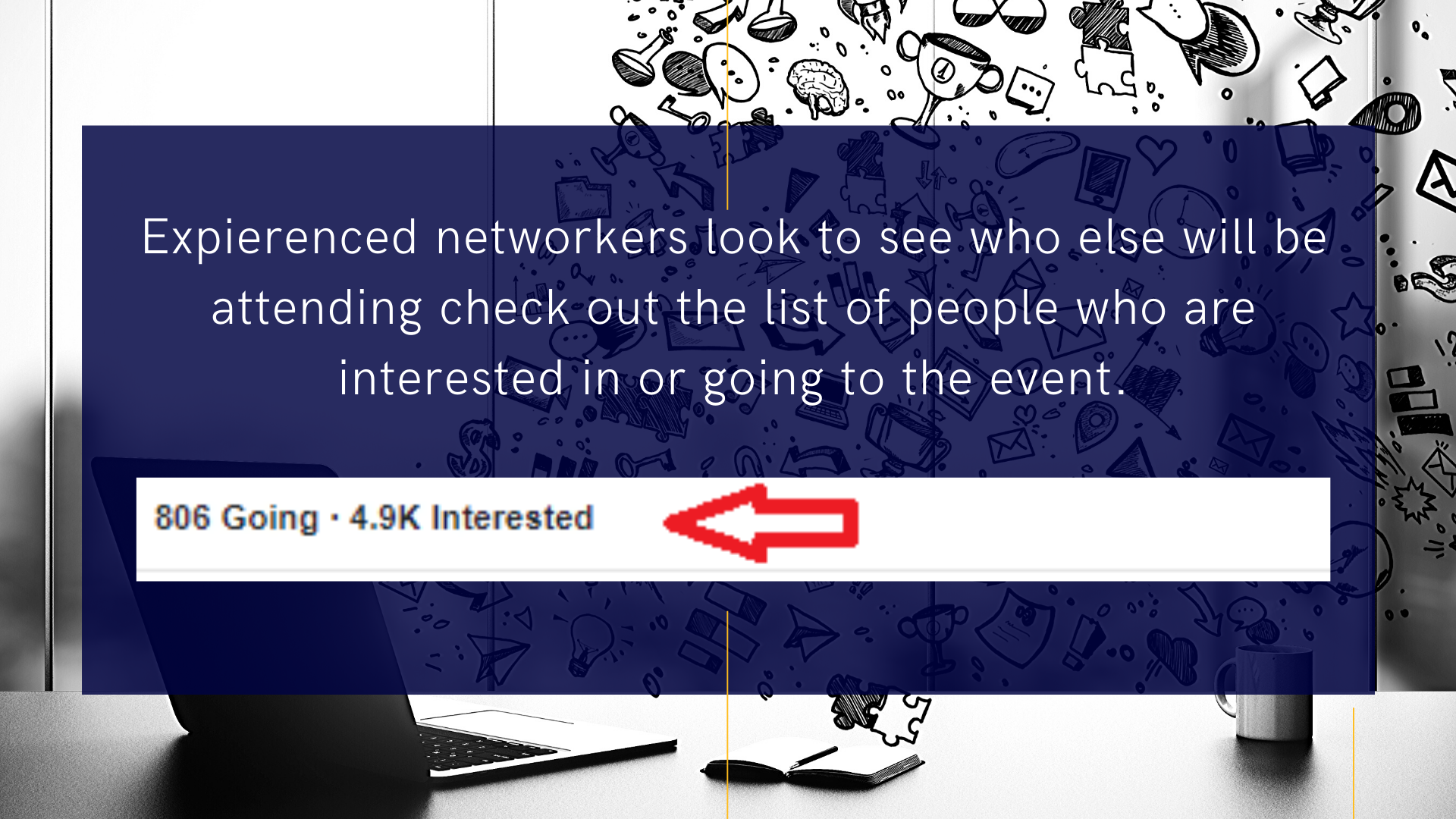
B. Create a community online
Set the foundation for successful networking during the event and will help the attendees find each other and keep in touch.
By creating a place where attendees can ask and answer questions about the event, as well as get to know each other a little bit before the event launches, will help drive off-line discussions and facilitate networking.
Where to host discussions
-
On the webpage of your event: create a forum or a discussion board
-
Your event’s Facebook event page: there is a specific place for discussions
-
Industry groups (such as Facebook and LinkedIn)
-
On a social media post, or on posts across multiple platforms
-
For a wide, international audience, consider using Reddit or Quora
You can gain valuable insights about what your audience is looking for and what their hot topics are, while creating a subtle space for pre-event networking.
C. Build networking time into the schedule
If networking is one of the top reasons people attend events, then you need to build in ample time to allow guests to mix and mingle with each other.
An effective agenda has networking time spread throughout the day.
Where to include networking time in your conference:
-
Dedicated early morning networking events for during breakfast, or specific off-site restaurants and cafes where are networking can happen
-
During coffee and meal breaks
-
Afternoon networking session prior to a closing keynote or general session that attendees don’t want to miss
-
Early evening, post-keynote networking, or initial event reception
Planning the right amount of agenda time important. Here are some guidelines:
-
Refreshment breaks for groups of 100 or less should be a minimum of 15 minutes. For up to 1,000 guests, schedule 30 minutes. And for groups over 1,000 attendees, schedule 45 minutes.
-
Allow 30 to 40 minutes for a breakfast and a minimum of 45 to 60 minutes for lunch. Self-serve buffets usually require less time and are ideal for smaller groups. Plated meals take longer, especially if one server is used to serve multiple tables versus one server per table. This might vary depending on whether you will have your event catered or not, and where your venue is.
-
Evening events should be a few hours at the minimum, however, it might not be wise to have events that run late into the night if attendees are expected to show up for the morning session the next day.
Transitions as a place to facilitate networking
After a session, most attendees hopefully be invigorated and inspired with new ideas.
They will also most likely need some time to:
-
check their email,
-
check and post on social media,
-
listen to voicemails and return calls,
-
go to the washroom (hopefully no line…!)
-
grab a quick coffee or a snack,
-
moving from one event room to another.
If you only have 2-3 minutes to do all this—networking drops to low priority.
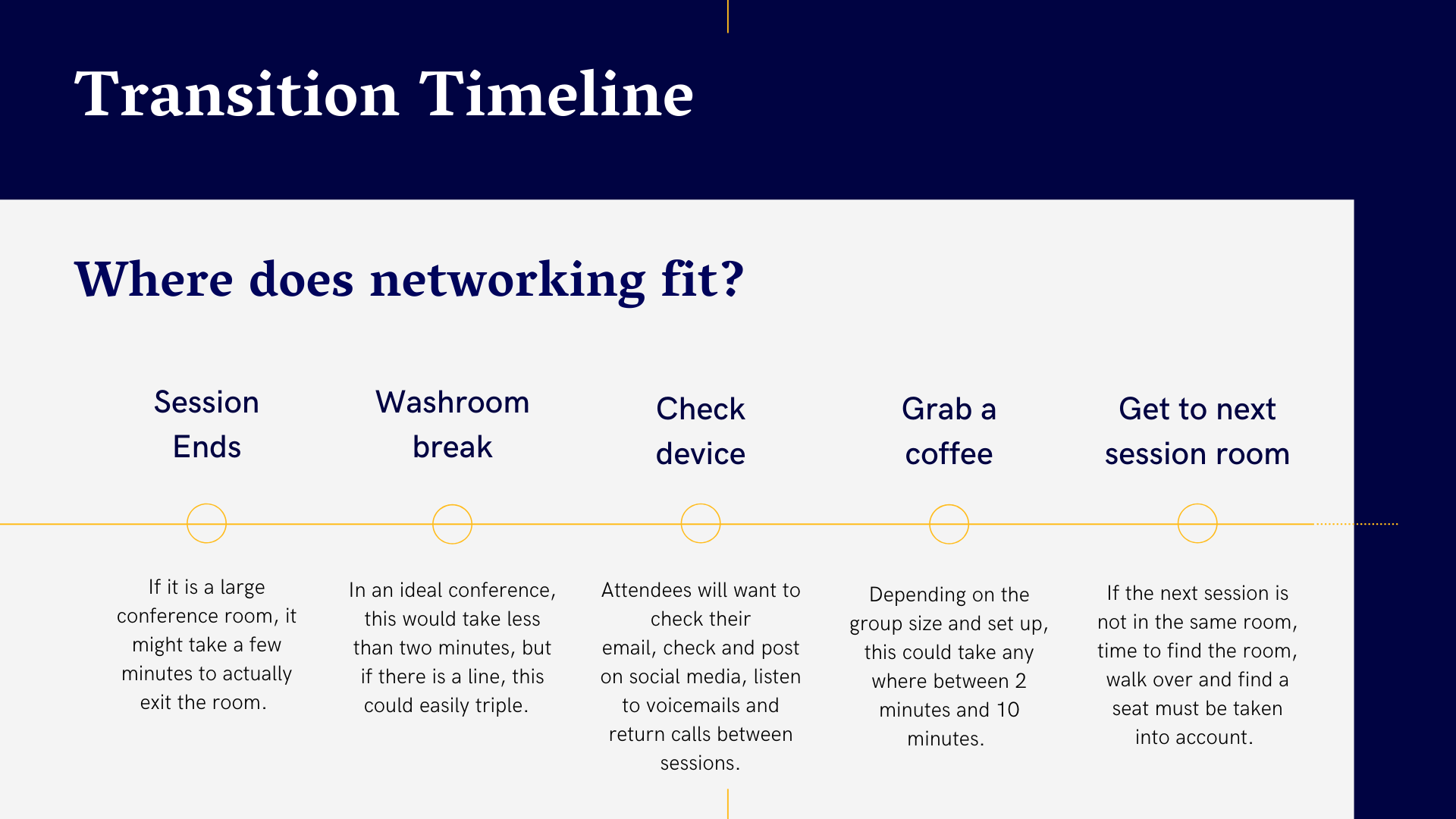
But what a missed opportunity, as this is when attendees are brimming with inspiration.
When building your schedule, imagine yourself in your attendee’s shoes. How long would it take to do all of the lists above, as well as have a few conversations?
Make sure your transition times reflect this.
After-hours networking spaces and activities
It’s hard to remain focused and energized the conference is non-stop from all-day and all night.
Attendees who are on the introverted side might appreciate smaller, more intimate networking opportunities. Allow attendees time to see the sights, quiet moments to digest and reflect on what they’ve been learning, and time to spend one-on-one with other attendees.
D. Optimize venue layout
A large part of the success of networking during an event depends on whether or not people have the space and time to speak with one another.
If the attendees cannot find space to have a conversation it could discourage networking.
The layout of your venue matters; if the networking area is so packed they can’t hear each other speak, there is a confusing layout where the networking area is too far away from the conference rooms, if there isn’t a good flow so attendees get congested in key areas, or if there isn’t ample room to stop and have a chat—it can have a negative impact on attendees ability to connect.
Make sure when you are choosing your venue, you think about where and when people will network. Will hundreds of people pour out of the keynote then directly into
It is important to work on networking opportunities before the event launches.
By following the above-mentioned steps, you’ll set the tone for your attendees that will encourage networking during the event.
2. Eliminate networking obstacles
You’ve set the foundation for networking during your event, now it’s time to think of the atmosphere that will contribute to and encourage networking.
Your main task is to find and eliminate obstacles that can ruin this atmosphere.
Networking activities during an event should be aimed at eliminating the three main networking obstacles:
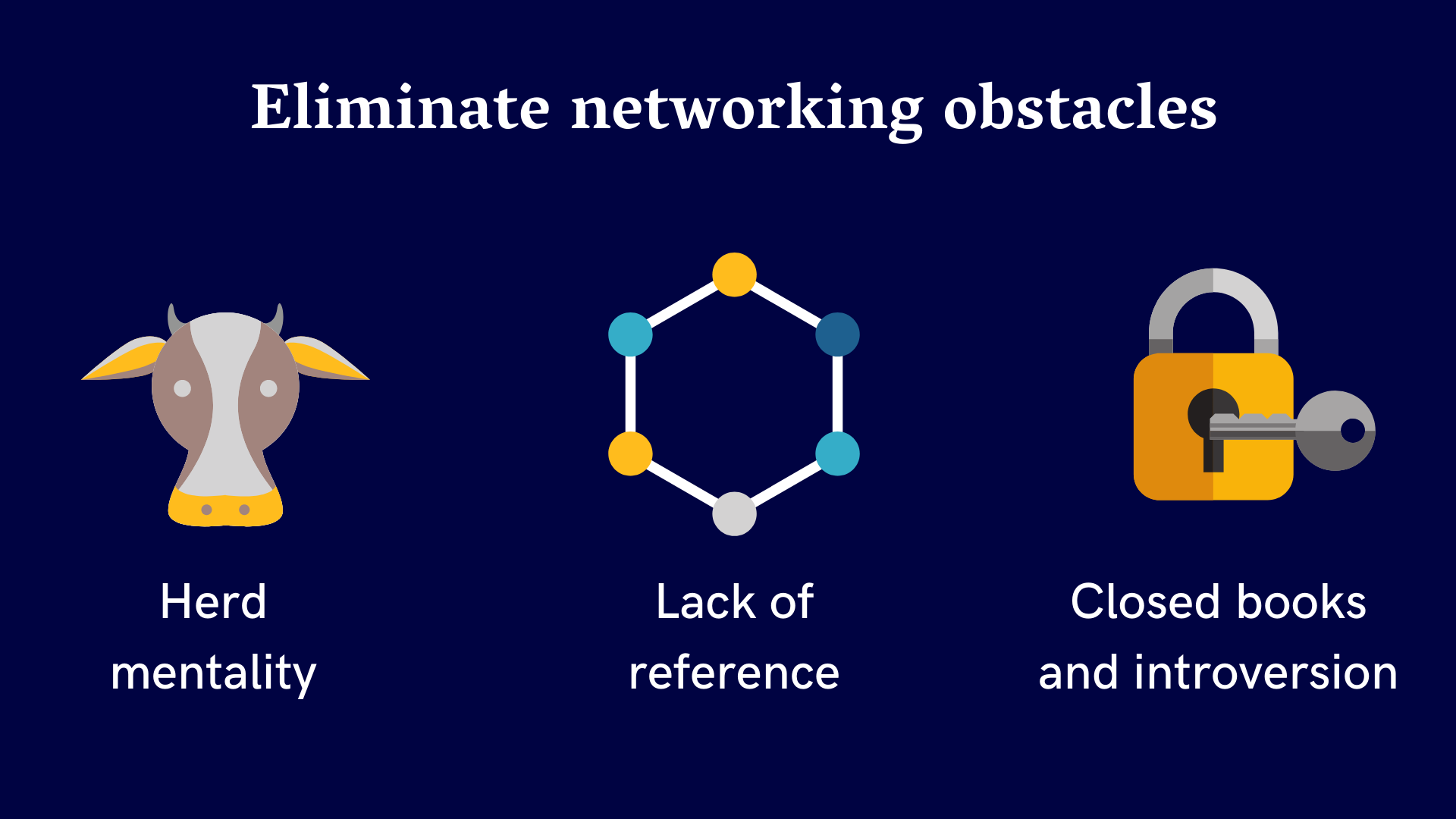
-
Herd mentality
Sometimes when people are grouped together, it influences the way they behave, which may be inclusive for some people but push away the others. Networking activities should be aimed at bringing forward the main interest that unites all the attendees.
You can do it by organizing ‘table topic’ discussions guided by some of the keynote speakers or by offering the attendees to play a ‘People Organizer’ game, where they have to break into groups according to their interests.
-
Lack of reference
While this obstacle can be partly eliminated on the pre-event stage by having the attendees join the online community of your event, some people may still lag behind and feel uncomfortable during the event.To eliminate this obstacle, you need to include ice-breaker activities. For instance, at the beginning of the panel discussions, you can have one of the keynote speakers play a ‘Question Ball’ game, where they ask some of the attendees random questions that pop up on the question ball.
Another great idea is a paper airplane game, where a keynote speaker launches a paper airplane with a question, and whoever gets the airplane has to answer the questions. The questions can be related to the topic of the panel discussion or it can be a general question to help the audience get to know each other.
-
Closed books
Despite the friendly atmosphere, some people can be hard to crack. They maybe naturally introverted, or have a hard time share information about themselves. How can you create events that will help them network as well?This can be changed by encouraging the audience to play games or set “get to know you” activities during workshops and smaller group activities (such as networking breakfasts). This creates an inclusive atmosphere for every attendee in the group.
When organizing networking activities that will take place during your event, you should take into account the number of attendees as well as the capacity of your value.
You should create an atmosphere that people will feel comfortable in, thus cultivating long-term clients and helping people get the most out of your event.
3. Utilize technology
Today, event organizers widely employ technology in almost every stages of event preparation.
Productivity tech, such as planners, are used to facilitate event preparation.
Online resources, like Flatfy, are used to accommodate all the attendees, and sometimes even facial recognition and AI is employed to keep the event venue a safe place to attend.
In terms of encouraging networking, however, event organizers can greatly benefit from event organization apps, which allow:
-
Creating digital badges, which the participants of the events automatically receive upon registration. This allows the event attendees to locate each other.
-
Tracking the networking hubs, where the participants gather in between the panel discussions and workshops.
-
Live surveys and in-session discussions, helping participants interact with each other during the keynote speeches, and while helping with audience engagement.
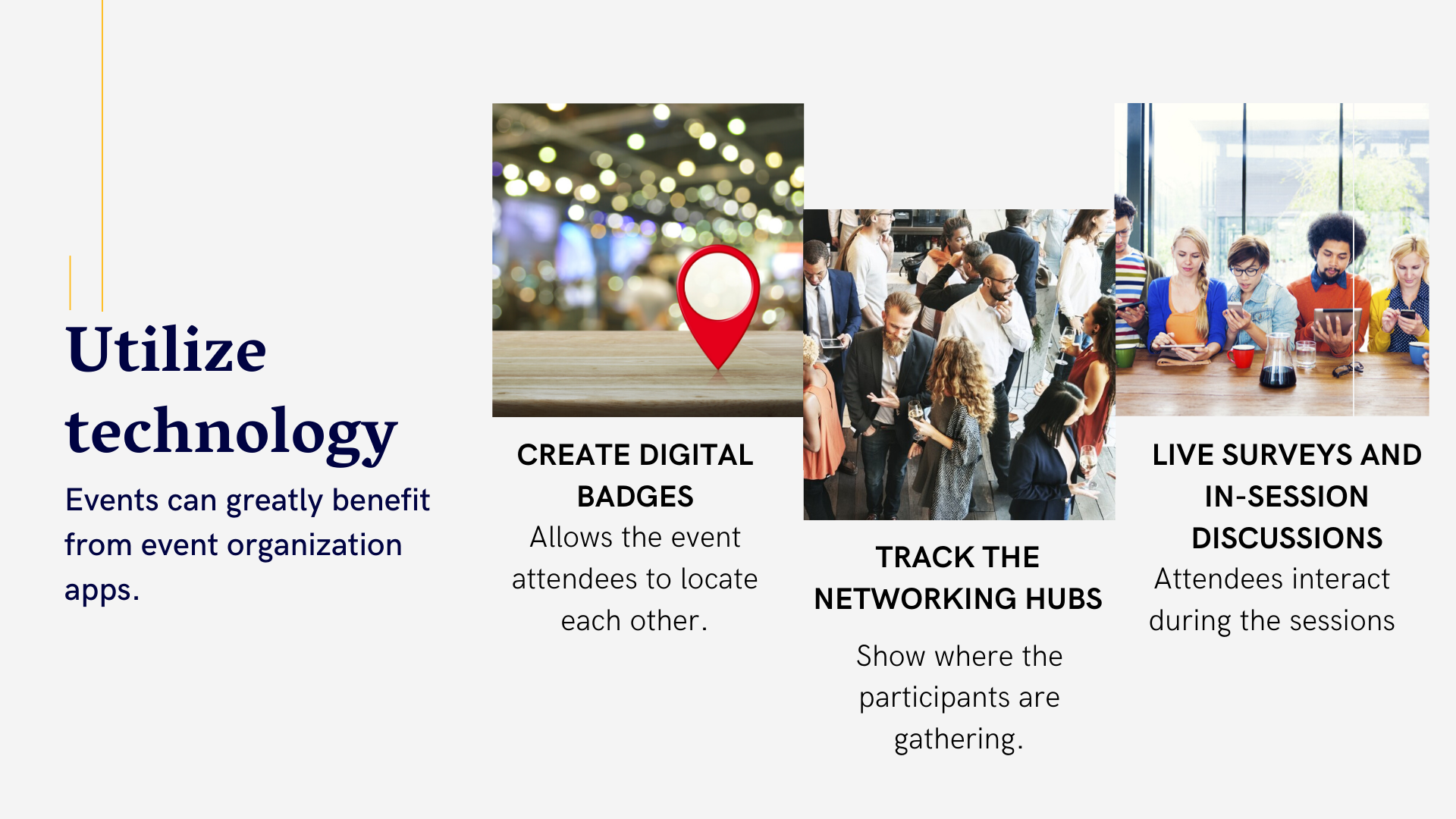
Technology helps create a seamless experience to keep the participants engaged and encourage networking.
In conclusion:
People want to attend events that provide great networking opportunities. Attending events allows them to find new useful business connections, and, as an event organizer, your task is to facilitate that.
Networking should be your priority on the pre-event stage already to make sure that all attendees have equal opportunities to communicate.
During the event, your main task is to eliminate any obstacles that could get in the way of effective networking. And, using technology along the way will help you create the right atmosphere that nurtures and encourages networking.
What to read next:
- The quick guide to networking
- 3 Reasons to start building yourself a strong network of speakers
- Social networking: what to talk about on Facebook, Twitter, and LinkedIn
- Connect with the right people: Technology-enhanced events with SpeedNetworking
- World of Speakers E.22: Creating real connections with Michelle Tillis Lederman
About the author: Ryan is a passionate writer who likes sharing his thoughts and experience with the readers. Currently, he works as a digital marketing specialist at https://flatfy.ro. He likes everything related to traveling and new countries.
Looking for the perfect speaker for your next event? SpeakerHub helps connect event organizers from thousands of speakers from around the world, for free.






